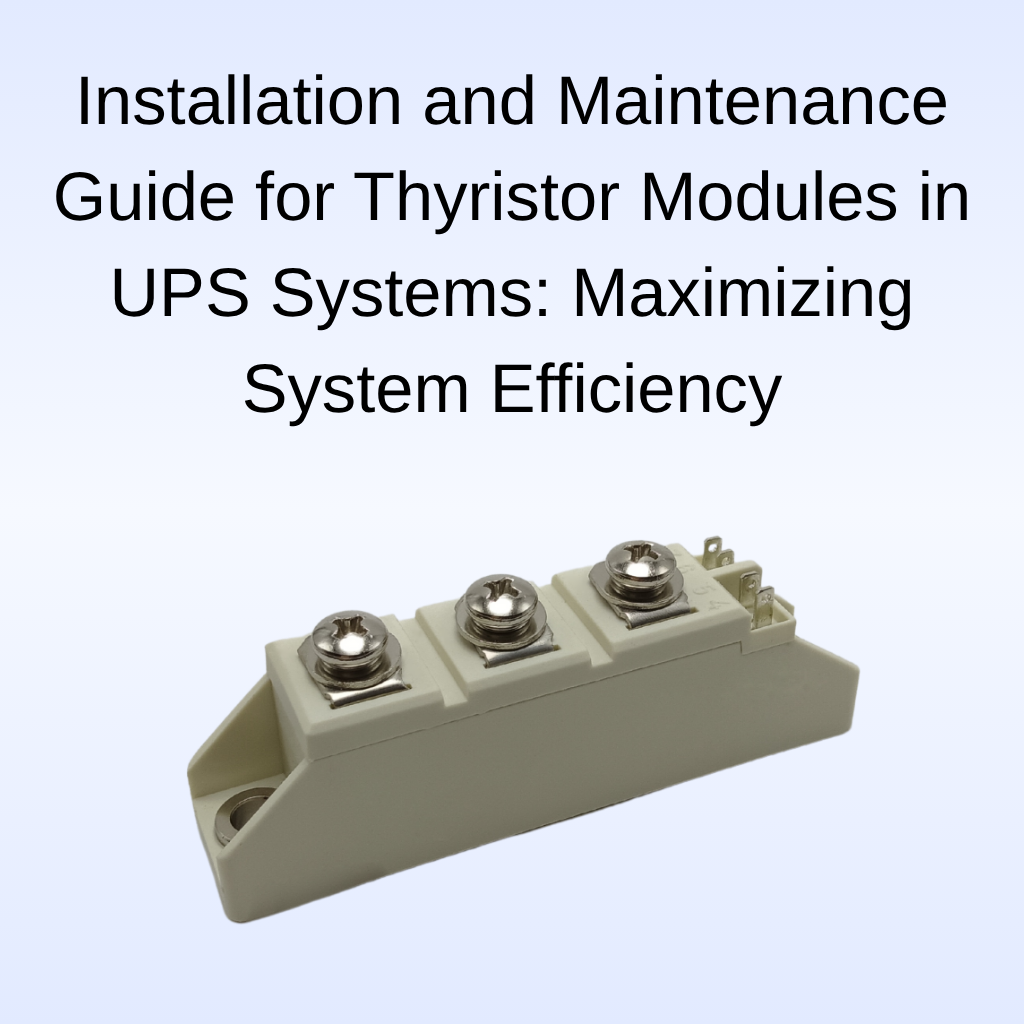Installation and Maintenance Guide for Thyristor Modules in UPS Systems: Maximizing System Efficiency
Thyristor modules are integral to the performance of Uninterruptible Power Supply (UPS) systems, which are responsible for providing continuous power to critical equipment. To ensure that thyristor modules function efficiently, it is essential to follow proper installation and maintenance procedures. This guide will help you understand the key steps for installing and maintaining thyristor modules, including key considerations for high surge current, low on-state voltage, and industrial phase control.
Step 1: Installation of Thyristor Modules
The successful installation of thyristor modules directly impacts the performance and longevity of a UPS system. Proper installation ensures that the system runs efficiently, with minimal risk of component failure. Key considerations for installing thyristor modules include:
Compact Package and Space Management: Thyristor modules are often designed in a compact package, making installation simpler and more space-efficient. However, ensure that the installation space provides sufficient ventilation for heat dissipation. Proper ventilation is vital for preventing overheating, especially during high power usage.
Corrosion Protection: Most thyristor modules come anodized to enhance their resistance to corrosion. When installing, ensure that anodized surfaces are undamaged, especially in environments where exposure to moisture or corrosive agents is possible.
Power Converter Integration: Thyristor modules play a key role in the power converter of a UPS system. Ensure the modules are properly integrated into the power converter for efficient DC to AC conversion. Make sure all wiring is secure to prevent inefficiencies or potential failure of the UPS system.
Handling High Surge Current: UPS systems often experience high surge current during startup or load transitions. Ensure that the thyristor modules are capable of managing these surges. Select modules rated for high surge handling to protect the system from power fluctuations.
Step 2: Testing the Installation
Once the thyristor modules are installed, it’s essential to test them to ensure they operate correctly. Thorough testing guarantees that the modules will perform optimally under varying load conditions:
Testing for Low On-State Voltage: The low on-state voltage of thyristor modules helps reduce power losses and boosts system efficiency. Verify that the voltage levels are within the desired range to maximize efficiency.
Industrial Phase Control Testing: For industrial UPS systems, ensure that the industrial phase control feature is functioning correctly. This feature stabilizes voltage and helps maintain power reliability, especially during fluctuating loads.
Surge Current Testing: Perform surge current tests to ensure the modules can absorb high surge currents without causing damage or system downtime. The UPS should be able to manage surges effectively during power transitions.
Step 3: Maintenance of Thyristor Modules
Regular maintenance of thyristor modules ensures long-term performance and reliability. Key maintenance steps include:
Routine Visual Inspections: Periodically check for signs of damage, such as discoloration, cracks, or corrosion. If any issues are found, replace the damaged modules immediately to prevent system failure.
Cleaning and Debris Removal: Regularly clean the modules and surrounding components to remove accumulated dust and debris. Use compressed air or a soft brush to prevent dirt buildup, which can cause overheating and inefficiency.
Thermal Management: Ensure the thermal management system, such as fans and heat sinks, is functioning properly. Thyristor modules generate heat during operation, and proper cooling is essential to prevent overheating and extend their lifespan.
Surge Current Monitoring: Continuously monitor the system for surge current issues. If frequent surge currents are detected, assess whether the modules are operating within their rated capacity and adjust the load accordingly to prevent damage.
Conclusion
Proper installation and maintenance of thyristor modules are vital for ensuring UPS system efficiency. By focusing on key features such as high surge current handling, low on-state voltage, and industrial phase control, you can optimize system performance and reliability. Regular maintenance and proper care will extend the lifespan of thyristor modules and enhance the efficiency of the UPS system, ensuring uninterrupted power supply for critical equipment.
READ MORE:
Installation and Maintenance Guide for Thyristor Modules in UPS Systems: Optimizing Performance
Installation and Maintenance Guide for Thyristor Modules in UPS Systems
Case Studies of Thyristor Modules in Uninterruptible Power Supply Systems: Applications in Industry
Case Studies of Thyristor Modules Used in Uninterruptible Power Supply Systems
Best Practices for Selecting Thyristor Modules in UPS Systems

